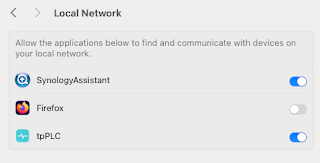We exported the Visio diagrams, one at a time, in Enhanced MetaFile (EMF) format, and then imported them into PowerPoint.
Sadly, we noticed that certain boxes, drawn with dotted lines ( used to represent optional components in the diagrams ), acquired solid lines ( used to represent in-scope and "mandatory" components ).
The same also happened using Windows MetaFile (WMF) format.
This rather reduced the effectiveness of the diagrams, which was a bit of a pain.
Thankfully, my colleague jumped onto Google ( oh, the irony, given that we had an issue with three Microsoft products - Visio and PowerPoint, running on Windows ), and found this MS article: -
In Microsoft Office Visio 2003, when your drawing contains objects that use a dashed or a dotted line pattern, and you copy and paste the objects to a Microsoft Office document or to a document in another program that supports linked and embedded objects, you may find that some of the embedded Visio objects appear with a solid line pattern. Objects that use a line pattern with thick, short lines retain their formatting, whereas objects that use a line pattern with thinner, longer lines do not retain their formatting. The line pattern of these embedded objects are converted to solid lines.
You may also experience these symptoms when you export your drawings to Windows Metafile (.wmf) format.
You may also experience these symptoms when you export your drawings to Windows Metafile (.wmf) format.
There is a workaround: -
...
To work around this problem, increase the thickness of the line pattern of the embedded Visio object after you copy and paste the Visio drawing to the other program. To do so, follow these steps:
• Open the document that contains the embedded Visio drawing.
• Double-click the embedded Visio drawing in the document.
• Right-click the Visio object whose line pattern you want to modify, point to Format, and then click Line.
• In the Weight box, click the line thickness setting that you want, and then click OK.
• Click an empty area of the document outside the embedded Visio drawing.
• Save the document.
…
but this would have left us with TWO copies of each drawing, leading to a potential drift.
Therefore, we chose the solution …. to "hack" the Windows Registry :-)
…
To resolve this problem, create the
MetafileDashLineAsSolid
registry entry in the following registry key and set the
MetafileDashLineAsSolid
registry entry to the value that you want:
MetafileDashLineAsSolid
registry entry in the following registry key and set the
MetafileDashLineAsSolid
registry entry to the value that you want:
• Visio 2007
HKEY_CURRENT_USER\Software\Microsoft\Office\12.0\Visio\Application
HKEY_CURRENT_USER\Software\Microsoft\Office\12.0\Visio\Application
• Visio 2003
HKEY_CURRENT_USER\Software\Microsoft\Office\11.0\Visio\Application
HKEY_CURRENT_USER\Software\Microsoft\Office\11.0\Visio\Application
...
Once we did this, and re-imported the EMF drawings, all was well.
I did find it (briefly) ironic that I had to update the Windows Registry to let Visio and PowerPoint play nicely together, and could've ranted about Windows. But, do you know what ? I suspect I've had to do similar weird things to make stuff work on my Mac. Given that modern software typically leverages the graphics capabilities of the underlying OS, this is the way of the world :-)
PS I think we were using Office 2003


No comments:
Post a Comment